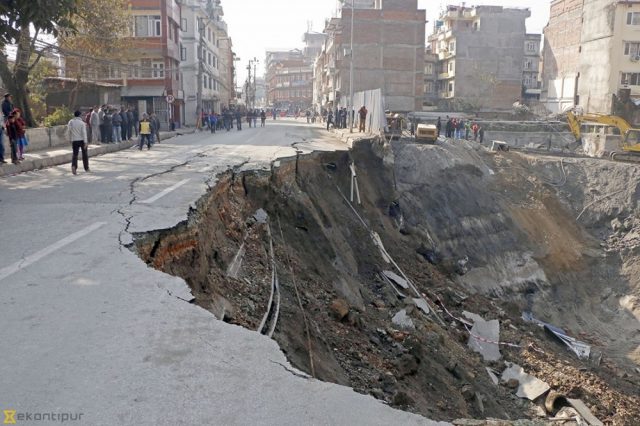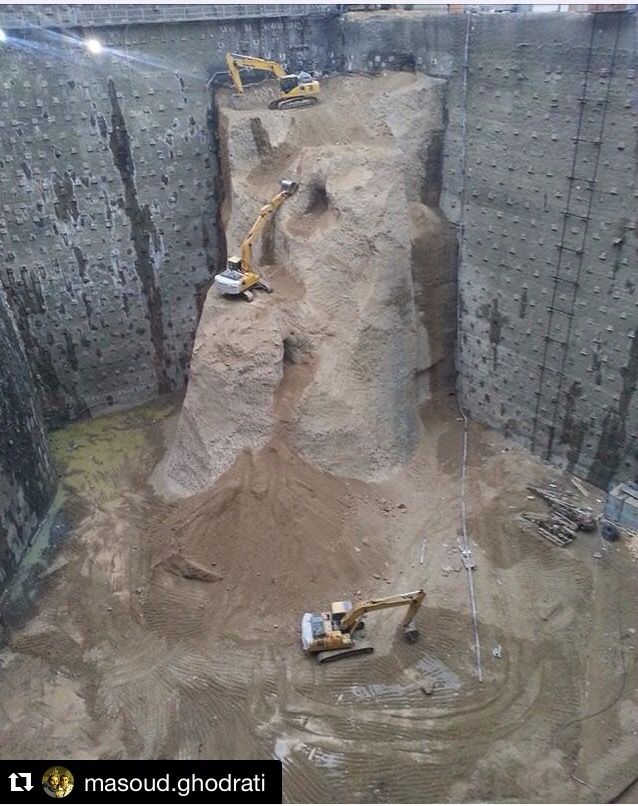9 January 2017
Naxal, Kathmandu: a landslide apparently caused by poor construction management
Posted by Dave Petley
Naxal, Kathmandu: a landslide caused by poor construction management
At 7 am yesterday morning a section of the Bhagwati Bahal-Bal Mandir road in Naxal, Kathmandu collapsed into a deep excavation, closing this busy highway. Ekantipur has the best image of the site that I have seen so far:

The collapsed road section in Naxal, Kathmandu, via eKantipur
.
The site is an excavation for a new 5 star hotel, provisionally planned to be Hilton Doubletree. The Kathmandu Post has a good description of the situation:
The crumbling of the road section between Bhagwati Bahal Temple and Bal Mandir, an orphanage, swallowed up one lane of the street, opening a cavity measuring around 25 meters deep, according to the Department of Roads.
“The developers had dug a big hole around two to three storeys deep to lay the foundation of the proposed hotel. Use of heavy equipment too played a catalytic role in causing the accident,” Roads Department Spokesperson Dayakanta Jha said.
The damage caused to the road segment severely affected vehicular movement in area throughout Sunday. The department has said it would take at least two to three days to repair the segment.
A preliminary assessment carried out by Roads Department officials revealed that the incident occurred “despite taking proper precautionary measures”. “Pile foundation, which is required for such construction, is right in place,” Jha said.
The last statement is decidedly odd. I question whether the issue here is pile foundations; the problem is more likely to be with the retaining structure on the margin of the excavation. There are many techniques to allow this to be conducted safely; in this case something has clearly not worked as planned.
An example of what is possible appeared on Twitter last night, this is apparently the excavation for a new hotel from Iran:

An excavation for a new hotel in Iran, via Twitter


 Dave Petley is the Vice-Chancellor of the University of Hull in the United Kingdom. His blog provides commentary and analysis of landslide events occurring worldwide, including the landslides themselves, latest research, and conferences and meetings.
Dave Petley is the Vice-Chancellor of the University of Hull in the United Kingdom. His blog provides commentary and analysis of landslide events occurring worldwide, including the landslides themselves, latest research, and conferences and meetings.
There are a few methods of constructing a retaining wall for large foundations like this. Examples include shotcrete and soil anchors (as shown in the Iran example), sheet piles (a line of interlocking metal plates, typically with soil anchors), or soldier piles (vertical piles which support bracing between them). The comment by Jha would imply the latter, but the pictures don’t show any evidence of piles along the wall. Instead it shows what appears to be a layer of concrete on the face, which wouldn’t do much to support the slope. Even in the developed world walls like this experience a high rate of failure; as they’re temporary structures construction companies try and build them as cheaply as possible.
[Indeed, and thanks. This does not look like a piled retaining wall to me, which makes the comment about piles quite curious. The Kathmandu Basin is filled with ancient lake sediments, so ground conditions are both variable and challenging. D.]
Having spent more than 40 years at the point of the spear on excavation or slope stability projects, I have so many things that I want to know more about regarding what shows up on this site. I count my blessings about the level of competence I could count on, including knowing that it was sometimes missing.
Keep up the good work, and any relevant links!